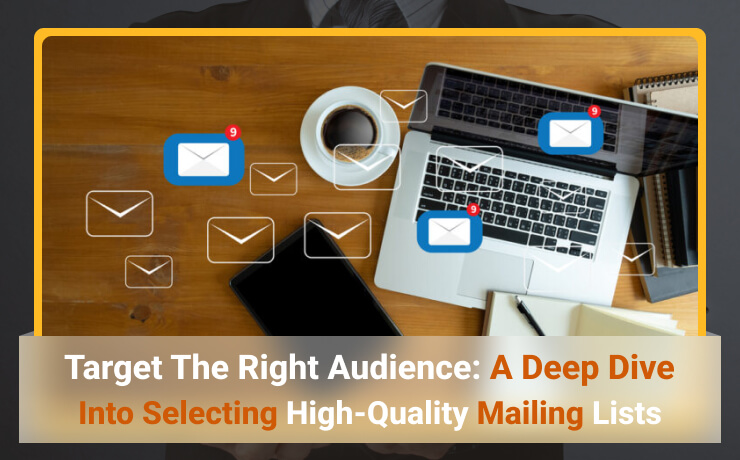Today, businesses of all sizes rely heavily on email marketing to reach their target audiences and drive sales. But the success of an email campaign hinges on the quality of the being used. A well-crafted, highly targeted mailing list can mean the difference between a successful campaign that generates leads and revenue, and one that falls flat, wasting time and resources.
Selecting the right mailing lists is an important task that requires a deep understanding of your target audience, their needs, and their preferences. It involves careful research, data analysis, and strategic decision-making to be certain that your messages reach the inboxes of those most likely to be interested in your products or services.
The following guide explores the intricacies of selecting high-quality mailing lists, providing valuable insights and actionable strategies for businesses seeking to maximize the impact of their email marketing efforts. From understanding the importance of targeted lists to building, buying, and maintaining them, we’ll look at best practices, compliance considerations, and the latest trends shaping the future of this ever-changing marketing channel.
Whether you’re a seasoned marketer or just starting to explore the world of email marketing, this guide will equip you with the knowledge and tools necessary to target the right audience, improve engagement, and drive better results for your business.
Building vs. Buying Mailing Lists
When it comes to acquiring mailing lists, businesses have two primary options: building their own lists or purchasing lists from third-party providers. Each approach has its own advantages and disadvantages, and the choice ultimately depends on your specific goals, resources, and marketing strategies.
Building your own mailing list involves organically growing a database of email subscribers through various tactics, like website sign-up forms, opt-in offers, event registrations, and social media campaigns. This method allows you to cultivate a highly engaged and interested audience from the ground up, because subscribers have proactively chosen to receive your communications.
However, this process can be time-consuming and resource-intensive, especially for new businesses or those with limited budgets.
On the other hand, buying mailing lists from reputable providers can provide instant access to a large pool of potential customers, saving time and effort. These lists are typically segmented based on various criteria, allowing for more targeted marketing efforts. But purchased lists often come with a higher risk of containing outdated or inaccurate data, leading to lower engagement rates and potential compliance issues.
Basically, the decision to build or buy mailing lists should be based on a careful analysis of your business goals, budget, and resources. Many businesses opt for a hybrid approach, combining organically grown lists with carefully vetted purchased lists to strike a balance between quality and quantity.
Maintaining Data Quality and Hygiene
Monitor engagement metrics, such as open rates, click-through rates, and conversion rates, to identify segments of your list that may be becoming disengaged. Take positive steps to re-engage these subscribers through targeted campaigns or consider trimming away inactive addresses to maintain a highly engaged audience.
Regularly review and update your data collection and management practices for compliance with evolving privacy regulations and industry best practices. Put reliable data security measures in place to protect sensitive information and maintain the integrity of your mailing lists.
Segmenting Your Mailing Lists
Personalization goes beyond simply addressing recipients by name. It involves tailoring the content, messaging, offers, and overall experience to go along with each individual’s preferences, behaviors, and interests. This level of personalization not only increases engagement but also encourages a stronger connection with your brand, because subscribers feel valued and understood.
Use the data in your mailing lists and customer relationship management (CRM) systems to fill emails with personalized product recommendations, targeted promotions, and relevant content based on each recipient’s profile. Incorporate dynamic content blocks that adapt based on things like location, purchase history, or browsing behavior.
Consider using triggered email campaigns that are automatically sent in response to specific actions or milestones, like welcome emails for new subscribers, abandoned cart reminders, or post-purchase follow-ups. These timely and relevant communications can nurture leads and drive conversions.
Testing and Optimization Strategies
Even with the most well-crafted mailing lists and personalized campaigns, there is always room for improvement. Testing and optimization strategies are recommended for continuously refining your email marketing efforts and maximizing their impact.
A/B testing, also known as split testing, is a powerful technique that allows you to compare the performance of two variations of an email campaign against each other. By testing elements like subject lines, email copy, calls-to-action, or design elements, you can see things from the viewpoint of your audience, what motivates, them, interests the, etc., and make data-driven decisions.
“Multivariate testing” takes this concept further by testing multiple variables at the same time, providing a more complete understanding of the interplay between different elements and their impact on overall performance.
In addition to A/B and multivariate testing, think about using automation and triggered campaigns based on subscriber behavior and interactions. These can include abandoned cart reminders, post-purchase follow-ups, or re-engagement campaigns for dormant subscribers.
Continuously monitor key performance indicators (KPIs) like open rates, click-through rates, conversion rates, and unsubscribe rates to find areas for improvement. Use analytics tools and heat mapping to gain deeper insights into how subscribers interact with your emails, influencing future optimization efforts.
Regularly review industry benchmarks and best practices and stay up to date with new trends and technologies in email marketing. This way, your strategies remain relevant and effective.
Compliance and Privacy Considerations
Compliance with relevant laws and regulations has become increasingly important. Failure to adhere to these standards can result in hefty fines, legal repercussions, and damage to your brand’s reputation. So, it is necessary to prioritize compliance and privacy considerations when building and managing your mailing lists.
The primary focus should be on obtaining proper consent from subscribers. Laws like the General Data Protection Regulation (GDPR) in the European Union and the require explicit permission from individuals before adding them to your mailing lists. Make sure your opt-in processes are clear, transparent, and easily accessible.
Put strong data security measures in place to protect the personal information of your subscribers, including encryption, access controls, and regular security audits. Develop and communicate a clear privacy policy that outlines how you collect, use, and safeguard subscriber data.
Stay current with the latest industry regulations and best practices, as well as any changes or updates to existing laws. Regularly review and update your compliance processes to provide for ongoing adherence.
Also, provide clear and easy-to-use unsubscribe options in every email, respecting the preferences of those who no longer wish to receive your communications. Promptly remove unsubscribed addresses from your mailing lists to avoid potential legal issues and maintain a positive reputation.
Best Practices for Mailing List Management
Effective mailing list management is necessary for maintaining the integrity, quality, and performance of your email marketing campaigns. By sticking to industry best practices, you’ll know that your lists remain up to date, compliant, and optimized for maximum impact.
First and foremost, prioritize permission-based practices. Only add subscribers who have explicitly opted-in to receive your communications and provide clear and accessible ways for managing preferences or opting out. Respect the privacy and preferences of your audience to build trust and maintain a positive reputation.
Use good data hygiene protocols, regularly removing invalid, bounced, or inactive email addresses from your lists. Use email verification and list cleaning services to maintain accurate and current data, improving deliverability and engagement rates.
Segment your lists based on relevant criteria, like demographics, interests, behaviors, or purchase histories. This allows for more targeted and personalized messaging, increasing the relevance and quality of your campaigns with each audience subset.
The Future of Mailing Lists and Email Marketing
As technology continues to evolve and consumer behavior shifts, the world of email marketing and mailing list management is poised for big changes. Staying ahead of these trends and adapting to emerging best practices will be critical for businesses that want to maintain a competitive edge.
One key trend is the increasing emphasis on data privacy and consent. With regulations like GDPR and growing consumer awareness, businesses will need to prioritize transparent and ethical data collection practices, securing explicit consent from subscribers and providing clear control over personal information.
Advancements in artificial intelligence (AI) and machine learning will also shape the future of email marketing. These technologies will allow for more sophisticated segmentation, personalization, and content optimization, delivering highly tailored and relevant experiences to each subscriber based on their unique behaviors and preferences.




